
4 Ways To Measure Weed Without Scales
Measuring out marijuana is best done with digital scales. However, there are some simple ways that can help get at least a ballpark measure of your weed using basic household equipment. Keep reading to find out how you can measure weed when you have no scales handy.
We’ve all been there; you need to weigh out some weed and, for whatever reason, you haven’t got your scales handy or the batteries in your trusted digital device are dead. In this post, we’ll explore 4 different ways that can help get a rough measurement of your weed without digital or analogue scales, using common household items, your mobile phone or just your hands or eyes.
Understanding weed measurements
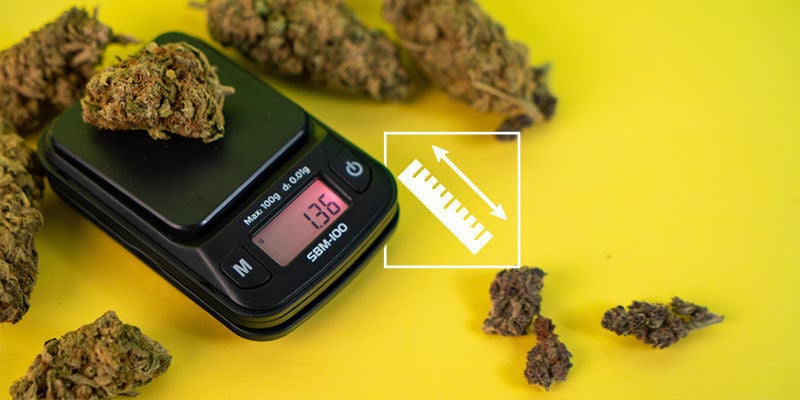
Weed is usually measured and sold in grams, although outside of Europe it’s often also sold by the ounce. Some of the most common cannabis measurements you’ll find around the world include the following:
- 1g, also sold as a “g” or “a stick”
- 3.5g or an “eighth” (as in ⅛ of an ounce)
- 7g or a “quarter” (as in ¼ of an ounce)
- 14g or a half-ounce
- 28g or 1oz
- 1lb or 453g
Occasionally, you might find weed being sold by its cash value rather than weight. In those cases, you might stumble upon these terms:
- a nickel or $5 worth of weed
- a dime or $10 worth of weed
- a dub or $20 worth of weed
If you’re new to cannabis, you could be wondering how much weed goes into a joint. This really depends on how you roll and you might be surprised that there has actually been research on this topic. Investigation by Greg Ridgeway of the University of Pennsylvania conducted with Beau Kilmer of the Rand Corporation (2016) suggests that the average joint contains 0.3g of cannabis. This measurement holds up pretty well, as most smokers find they can yield between 2–3 standard joints out of 1g of bud.
Weed measurements reference cheat sheet

If you've grown used to always measuring weed with a scale, suddenly trying to picture certain amounts of bud without one can be tricky. That's why we've created this cannabis measurement cheat sheet; to provide very rough guidelines for how much bud makes up, for example, an eighth of an ounce. Remember, measuring weed without a scale is far from an exact science, and the measures we describe in this cheat sheet should serve as a point of reference only.
-
1g — 1 gram of cannabis is roughly equivalent to the size of a medium–large grape.
-
3.5g (⅛ ounce) — 1/8th of bud (or 3.5 grams) will usually be the size of a medium-sized kiwi fruit.
-
7g (¼ ounce) — 7g or ¼ ounce of cannabis buds will be the size of a medium–large apple.
-
14g (½ ounce) — 14g or ½ ounce is roughly the size of a blood orange or pomelo.
-
28g (1 ounce) — 28g or 1 ounce of cannabis will usually be the size of a medium coconut.
-
453g (1 pound) — 1 pound of cannabis (or 453g) will be roughly the size of a watermelon.
Note: The comparisons we are making here are based on SIZE, not weight.
4 DIY methods for measuring weed without scales
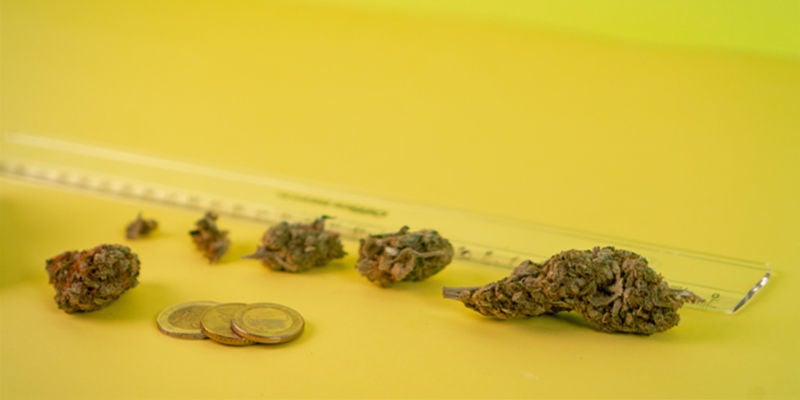
We’ve all been in a situation where we needed to weigh up some weed but, for whatever reason, there were no scales on hand. To help you out in this tricky situation, below you'll find 4 creative ways of measuring weed without scales. Note that these techniques obviously aren’t 100% accurate, but they should be able to give you a reference measurement of the amount of weed you’re dividing up.
Using a ruler and a penny
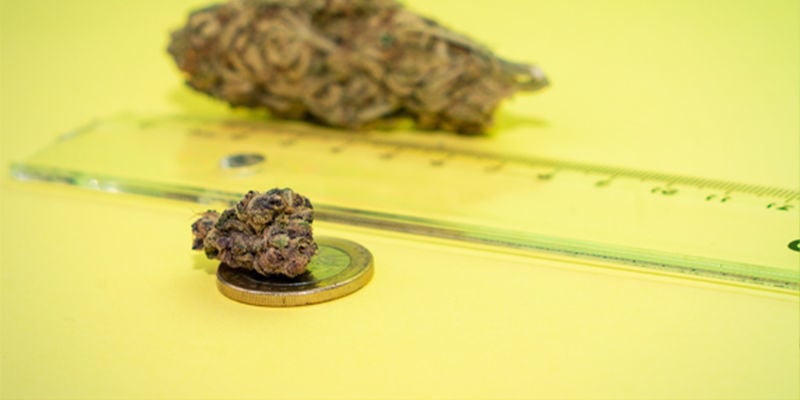
This is arguably one of the oldest tricks in the book, and all you need is a ruler, a pencil, and a penny (or any other coin whose weight you know). Balance the ruler on top of the pencil (make sure the pencil sits neatly in the middle of the length of the ruler) to create makeshift seesaw-like scales. Place the coin on one end and start to pile your nugs on the other end until the two sides balance. Use the list below for an estimate of the weight of the coin you might be using in your scales:
- 1 cent (0.01 USD): 2.5g
- 1 nickel (0.05 USD): 5g
- 1 dime (0.10 USD): 2.27g
- 1 EU cent (0.01 EUR): 2.30g
- 2 EU cents (0.02 EUR): 3.06g
- 5 EU cents (0.05 EUR): 3.92g
- 1 penny (0.01 GBP): 3.56g
- 2 pence (0.02 GBP): 7.12g
- 1 CAD cent (0.01 CAD): 2.35g
- 5 CAD cents (0.05 CAD): 3.95g
- 5 AUD cents (0.05 AUD): 2.83g
- 10 AUD cents (0.10 AUD: 5.65g
If you are using different coins, you should be able to find out their weight fairly easily by searching online.
Using homemade coat hanger scales
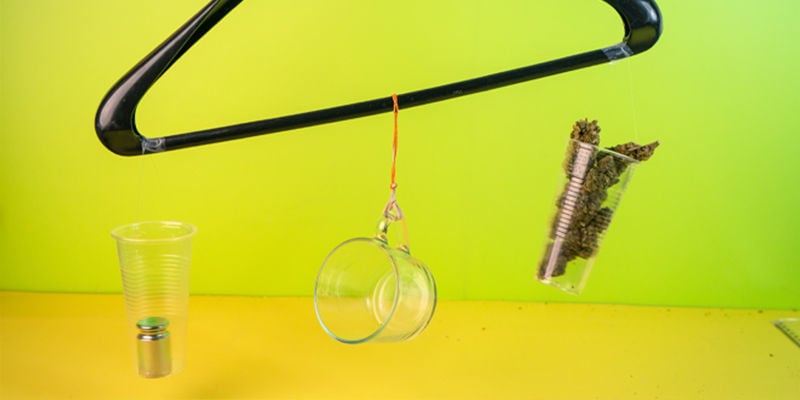
Similar to the penny scales mentioned above, coat hanger scales work by estimating the weight of your bud compared to another object. To make your scales, first use a string or fishing wire to hang a relatively heavy object (such as a phone charger, for example) from the middle of the hanger. Like with the ruler balanced on the pencil in the penny scales we described above, this item should hang right in the middle of the hanger to help stabilize the scales.
Next, use fishing wire to tie a plastic cup on either side of the hanger. If your hanger has little hooks from which to hang dresses, tie the cups directly to those hooks. Finally, place an item whose weight you know or can easily find out (like a coin, a closed spice packet, etc.) in one cup, and start filling the other cup with bud until the scales hang straight.
Using a smartphone app
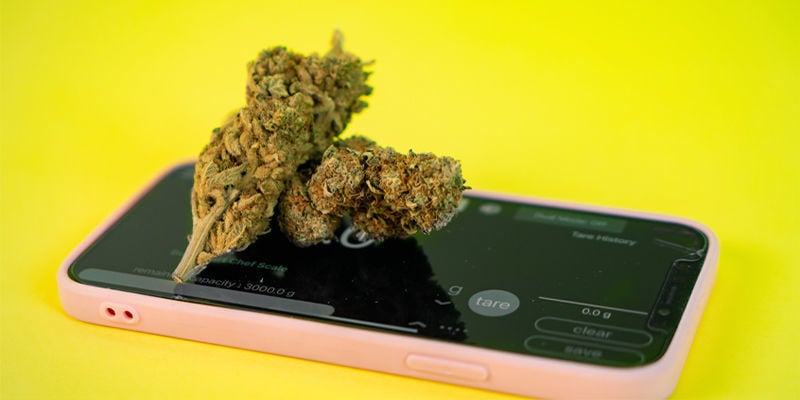
There are plenty of apps that can help you get a rough estimate of how much of something you’ve got on hand. Like the penny scale and coat hanger scale we mentioned earlier, keep in mind that these apps won’t provide you with an accurate weight of your weed. Instead, you can use them to get a ballpark measurement, and perhaps consider verifying it with the other methods we explained before.
We recommend reading the description before you download an application, as well as checking out its ratings and user comments. This should give you a good idea of whether or not the app can be useful for your intended purpose.
Using your hands and eyes
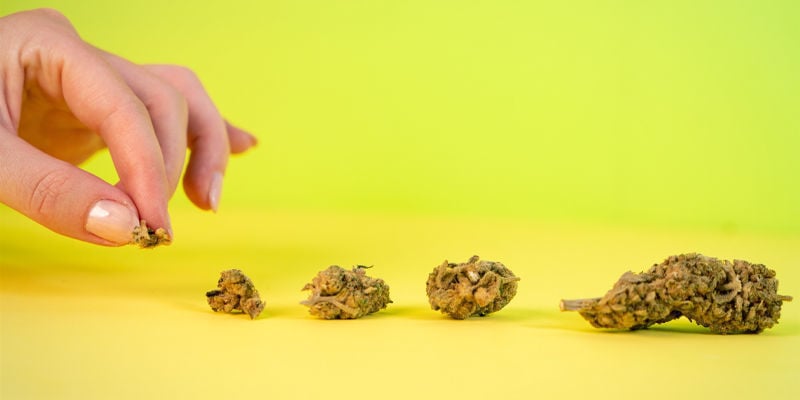
Sometimes, the only way to measure weed without scales is by estimating it yourself using your hands. Some people like to place buds in both hands and try to weigh them that way. Unfortunately, this is really inaccurate, as it is practically impossible to perceive minor weight changes using just your hands.
Alternatively, you could try to split your bud up by eye. If, for example, you’ve bought a ¼ ounce and need to divide it between yourself and a friend, we recommend putting the entire ¼ ounce onto a plain, white surface and dividing it into similarly-sized piles. Again, this is far from accurate, but more reliable than trying to sense the weight of buds by hand.
The risks of using DIY scales to measure weed
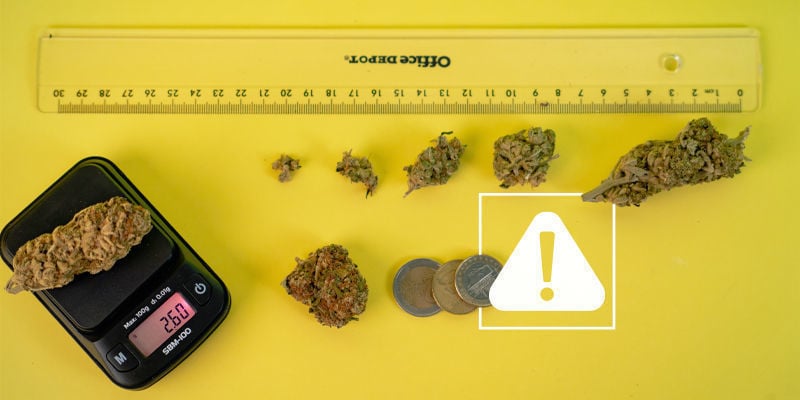
In this article, we explored 4 ways that can help you to measure weed without scales, should you find yourself in such situation. They are easy to perform and require items that you usually have at your disposal at home. Keep in mind that all of these methods have one very obvious downfall—they’re far from being accurate. If you need an exact measure of weed, the best way to get it is by using analogue or digital scales. Invest in your equipment and check out our full selection of weed scales at the Zamnesia Headshop here. You're sure to find a device that will serve you well for years and will help you get the most of your precious weed.
- Ridgeway G, & Kilmer B. (08/01/2016). Ridgeway, G., Kilmer, B. (2016) Bayesian inference for the distribution of grams of marijuana in a joint. Drug Alcohol Dependence. - https://pubmed.ncbi.nlm.nih.gov
-
 3 min
28 May 2024
How Much Weed Is In The Average Joint?
Rolling a joint is ultimately a personal exercise. But still, it can be illuminating and entertaining to know what the "average" joint looks like. Keep reading to find out how much weed is in the...
3 min
28 May 2024
How Much Weed Is In The Average Joint?
Rolling a joint is ultimately a personal exercise. But still, it can be illuminating and entertaining to know what the "average" joint looks like. Keep reading to find out how much weed is in the...
-
 3 min
6 May 2024
Top 10 Tools To Prepare A Joint Without Rolling
Here we look at 10 brilliant products that create perfect joints and spliffs (and a weed cigar), so you don't have to. You're getting high, so you may as well be lazy and let something else do the...
3 min
6 May 2024
Top 10 Tools To Prepare A Joint Without Rolling
Here we look at 10 brilliant products that create perfect joints and spliffs (and a weed cigar), so you don't have to. You're getting high, so you may as well be lazy and let something else do the...
-
 7 min
6 May 2022
How To Smoke Weed Without Smoking Supplies
For any stoner who has been caught out with great weed but nothing to smoke it with—never fear. Here are a few handy hacks to create a useable pipe, bong, or smoking alternative so you can still...
7 min
6 May 2022
How To Smoke Weed Without Smoking Supplies
For any stoner who has been caught out with great weed but nothing to smoke it with—never fear. Here are a few handy hacks to create a useable pipe, bong, or smoking alternative so you can still...
-
 4 min
29 January 2019
What Is The Best Lighter For You?
A lighter is just a lighter right? Nope, far from it. There are several aspects which need to be considered before selecting an essential incinerating device. There are subtle differences in...
4 min
29 January 2019
What Is The Best Lighter For You?
A lighter is just a lighter right? Nope, far from it. There are several aspects which need to be considered before selecting an essential incinerating device. There are subtle differences in...









 United States
United States













